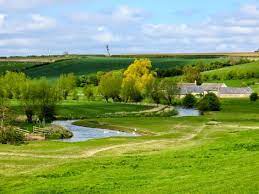Two Anglo-Saxon words, wen,
meaning to wind or meander and risc, which means rush or reed are joined to give us the the name of the Windrush river. Both the meanders and the reeds are still in view to this day. The modern course of the river includes flood meadows and open countryside, together with steeper sided banks in woodland areas. In the 8th centruy, the river was commonly crossed by fords, often stone lined. However many of these have been replaced by stone bridges, some of considerable age.
Typically a cold and clear waterway, atleast until recent problems with sewage pollution, the river today is detached from its commercial use in years gone by. There were many mills along its length and its course has been altered to meet local industrial need; for example straightening in Naunton and redirection into Bourton on the Water.
It flows through the Cotswold limestone, reflecting the many hues and shades of the local quarries, used to build cottages, manors and churches and add fine stone rooves. Looping and running in series of s-bends that in some cases can almost create islands it is a very attractive river.
In the past, the high water quality supported a teeming wildlife, including barbel, brown trout, chub, dace, gudgeon, perch, rainbow trout, roach and grayling. Large numbers of English freshwater crayfish could be found, now sadly displaced by the American signal crayfish. There are good hatches of mayfly, damsel fly and dragon fly together with sedges, olives and hawthorn flies.
Swans, geese and ducks are still plentiful and water voles, water rats and otters can be seen.
The otters have returned and the water vole population has recovered due to the management and improvement of the local grassland. Husbandry and farming practice has been adjusted to benefit the river habitat, for example the Water Vole Recovery Project.
The biggest challenge faced by the river is that of sewage pollution. Windrush Against Sewage Pollution (WASP) is a charitable organisation that has been formed to combat the illegal discharge of untreated and incompletely digested sewage into the river.






